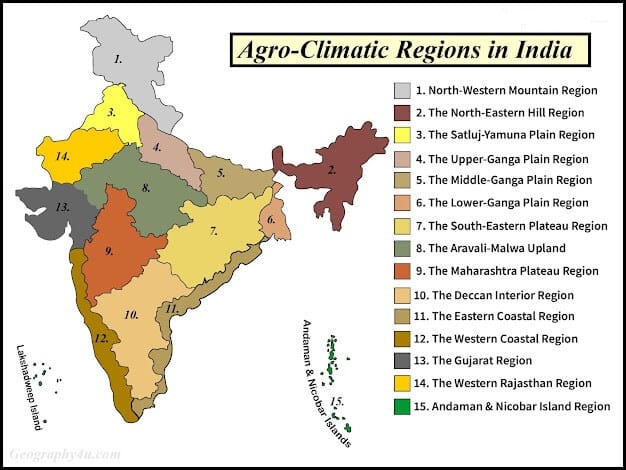Main Agro-Climatic Regions / Zones* of India

Agro-Climatic Regions of India
In 1988 the Planning Commission came up with a growth strategy based on a holistic approach of area planning for long-term resource efficiency and sustainability.
This identification of agro-climatic zones for the purpose of developing location specific research and development strategies for increasing agricultural production has been given the due impetus recently. In order to plan agricultural activities more accurately each region into sub regions based on soil, climate (temperature), rainfall and other agrometeorological characteristics. Planning Commission has demarcated the geographical area of India into 15 agro-climatic regions. These are further divided into more homogeneous 72 sub-zones.
The main objectives of agro-climatic regions are:
- to optimise agricultural production
- to increase farm income
- to generate more rural employment
- to make a judicious use of the available irrigation water
- to reduce the regional inequalities in the development of agriculture.
Agro-climatic zones are classified on the basis of homogeneity in agro- characteristics such as rainfall, temperature, soil, topography, water resources, and cropping systems.
- According to the Planning commission, 15 Agro-climatic zones are there in India.
- According to the NARP/ ICAR, 131 Agro-climatic zones are there in India.
Additional Information
- According to the ICAR, 8 Agro-ecological zones are there in India.
- According to the NBSS & LUP, 21 Agro-ecological zones are there in India.
| Zone | Region | State |
| Zone-1 | Western Himalayan Region | Himachal Pradesh, Jammu & Kashmir, Uttarakhand |
| Zone-2 | Eastern Himalayan Region | Arunachal Pradesh, Assam, Manipur, Meghalaya, Mizoram, Nagaland, Sikkim, Tripura, West Bengal |
| Zone-3 | Lower Gangetic Plain Region | West Bengal |
| Zone-4 | Middle Gangetic Plain Region | Uttar Pradesh, Bihar |
| Zone-5 | Upper Gangetic Plain Region | Uttar Pradesh |
| Zone-6 | Trans Gangetic Plain Region | Chandigarh, Delhi, Haryana, Punjab, Rajasthan |
| Zone-7 | Eastern Plateau and Hills Region | Chhattisgarh, Jharkhand, Madhya Pradesh, Maharashtra, Odisha, West Bengal |
| Zone-8 | Central Plateau and Hills Region | Madhya Pradesh, Rajasthan, Uttar Pradesh |
| Zone-9 | Western Plateau and Hills Region | Madhya Pradesh, Maharashtra |
| Zone-10 | Southern Plateau and Hills Region | Andhra Pradesh, Karnataka, Tamil Nadu |
| Zone-11 | East Coast Plains and Hills Region | Andhra Pradesh, Odisha, Puducherry, Tamil Nadu |
| Zone-12 | West Coast Plains and Ghat Region | Goa, Karnataka, Kerala, Maharashtra, Tamil Nadu |
| Zone-13 | Gujarat Plains and Hills Region | Gujarat, Dadra & Nagar Haveli, Daman & Diu |
| Zone-14 | Western Dry Region | Rajasthan |
| Zone-15 | Island Region | Andaman & Nicobar Islands, Lakshadweep |
Source:- Planning Commission (Khanna, 1989) has identified 15 resource development regions in the country,14 in the main land and remaining one in the islands of Bay of Bengal and Arabian Sea.

MCQs:-
Q. According to the Planning Commission of India, How many Agro-climatic zones are present in India?
- 15
- 20
- 121
- 130
Q. Which of the following is not a part of the Eastern Himalayan Agro-climatic zone?
- Assam
- Sikkim
- Orissa
- Arunachal Pradesh
- West Bengal
Q. In which year agro-climatic planning was introduced for inducing regionally balanced agricultural development in the country?
- 1964
- 1988
- 1990
- 1978
Q. The number of agro-climatic zones in Uttar Pradesh is?
- 3
- 7
- 8
- 11
| More General Agriculture Study Material | Open |
| More Agriculture Study Material | Open |
| Premium Study Material & Test Series | Open |
Sir please provide institutes stabilise year
Sir can u make notes about animal disease vaccine and the vaccine are developed by which institute like questions because in afo mains denfintede1 questions from this topic
sir i need some notes from soil and water conservation
Agro climatic regions- Good one